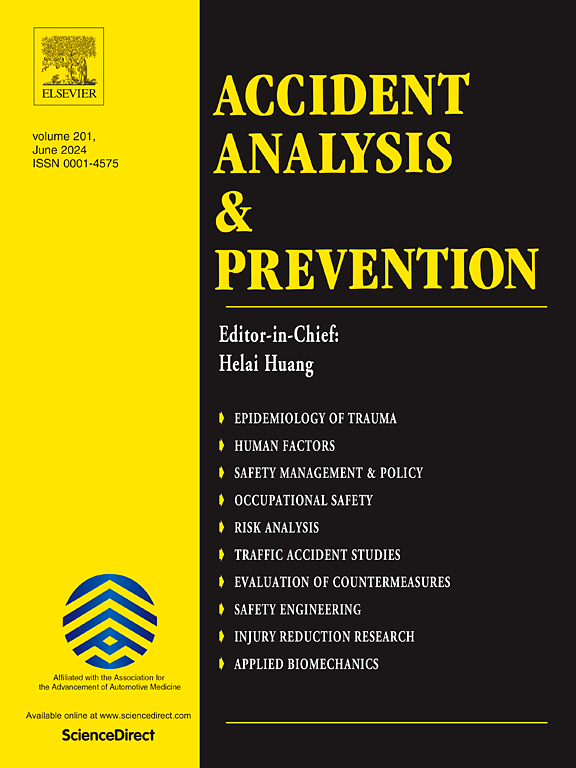Investigating the self-explaining performance of visual guidance facilities in extra-long spiral tunnels based on drivers’ spatial perception and visual attention distribution
IF 6.2
1区 工程技术
Q1 ERGONOMICS
引用次数: 0
Abstract
Enhancing the weak visual reference system is crucial for improving drivers’ spatial perception in extra-long spiral tunnels, which require continuous turns and uphill/downhill maneuvers. Using the Midicun Tunnel as a prototype, we tested three common visual guidance facilities—horizontal stripes, retroreflective rings, and edge markers—by constructing scenarios with each facility individually and in combinations of these facilities. A comprehensive indicator framework was developed to assess the impact of these facilities on drivers’ spatial perception and attention distribution. The self-explaining performance of each facility was evaluated using the matter-element model combined with the entropy weight method. Additionally, drivers’ subjective acceptance of each facility was measured using the Technology Acceptance Model (TAM), which offered insights into their internal expectations and cognitive state. The results reveal that drivers tend to drive close to the inside wall of the curve in the continuous curved section of a spiral tunnel. Installing edge markers improves the self-explaining performance of the tunnel’s horizontal right-of-way, increasing the distance between the vehicle and the tunnel wall. Installing the retroreflective ring guides drivers’ attention to the central area ahead, enhancing the longitudinal right-of-way. However, when used alone, it can lead to longer fixation durations and lower saccade frequencies, an issue that can be mitigated by combining them with other features. Comprehensive evaluations and subjective acceptance surveys indicate that scenarios with multiple facilities provide optimal self-explaining performance and best meet drivers’ psychological expectations. Among individual installations, edge markers are the most effective, followed by retroreflective rings, with horizontal stripes showing the weakest performance. Based on these findings, specific recommendations for optimizing visual guidance in spiral tunnels are provided, offering valuable insights for improving tunnel environments.
基于驾驶员空间感知和视觉注意力分布的超长螺旋隧道视觉引导设施自解释性能研究
在需要连续转弯和上下机动的超长螺旋隧道中,增强弱视觉参考系统是提高驾驶员空间感知能力的关键。我们以米迪村隧道为原型,测试了三种常见的视觉引导设施——水平条纹、反光环和边缘标记——通过单独或组合这些设施构建场景。开发了一个综合指标框架来评估这些设施对驾驶员空间感知和注意力分配的影响。采用物元模型结合熵权法对各设施的自解释性能进行评价。此外,使用技术接受模型(TAM)测量驾驶员对每个设施的主观接受程度,从而深入了解他们的内部期望和认知状态。结果表明,在螺旋隧道的连续曲线段,驾驶员倾向于靠近曲线内壁行驶。安装边缘标记提高了隧道水平路权的自解释性能,增加了车辆与隧道壁之间的距离。安装反光环可以引导司机注意前方的中心区域,增强纵向通行权。然而,当单独使用时,它可能导致更长的注视持续时间和更低的扫视频率,这个问题可以通过将它们与其他功能结合使用来缓解。综合评价和主观接受度调查表明,具有多种设施的场景具有最佳的自我解释性能,最符合驾驶员的心理期望。在个人装置中,边缘标记是最有效的,其次是反射环,水平条纹表现最差。在此基础上,提出了优化螺旋隧道视觉引导的具体建议,为改善隧道环境提供了有价值的见解。
本文章由计算机程序翻译,如有差异,请以英文原文为准。
求助全文
约1分钟内获得全文
求助全文
来源期刊

Accident; analysis and prevention
Multiple-
CiteScore
11.90
自引率
16.90%
发文量
264
审稿时长
48 days
期刊介绍:
Accident Analysis & Prevention provides wide coverage of the general areas relating to accidental injury and damage, including the pre-injury and immediate post-injury phases. Published papers deal with medical, legal, economic, educational, behavioral, theoretical or empirical aspects of transportation accidents, as well as with accidents at other sites. Selected topics within the scope of the Journal may include: studies of human, environmental and vehicular factors influencing the occurrence, type and severity of accidents and injury; the design, implementation and evaluation of countermeasures; biomechanics of impact and human tolerance limits to injury; modelling and statistical analysis of accident data; policy, planning and decision-making in safety.
 求助内容:
求助内容: 应助结果提醒方式:
应助结果提醒方式:


